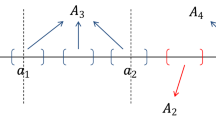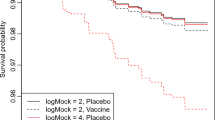Abstract
In HIV vaccine studies, longitudinal immune response biomarker data are often left-censored due to lower limits of quantification of the employed immunological assays. The censoring information is important for predicting HIV infection, the failure event of interest. We propose two approaches to addressing left censoring in longitudinal data: one that makes no distributional assumptions for the censored data—treating left censored values as a “point mass” subgroup—and the other makes a distributional assumption for a subset of the censored data but not for the remaining subset. We develop these two approaches to handling censoring for joint modelling of longitudinal and survival data via a Cox proportional hazards model fit by h-likelihood. We evaluate the new methods via simulation and analyze an HIV vaccine trial data set, finding that longitudinal characteristics of the immune response biomarkers are highly associated with the risk of HIV infection.

Similar content being viewed by others
References
Berk KN (2002) Repeated measures with zeros. Stat Methods Med Res 11(4):303–316
Centers for Disease Control and Prevention et al (2012) Principles of vaccination. In: Epidemiology and prevention of vaccine-preventable disease, 12th edn. Public Health Foundation, Washington, DC, pp 1–9
Commenges D, Jolly D, Drylewicz J, Putter H, Thiébaut R (2011) Inference in HIV dynamics models via hierarchical likelihood. Comput Stat Data Anal 55(1):446–456
Dagne GA, Huang Y (2013) Bayesian semiparametric mixture tobit models with left censoring, skewness, and covariate measurement errors. Stat Med 32(22):3881–3898
Gilbert PB, Peterson ML, Follmann D, Hudgens MG, Francis DP, Gurwith M, Heyward WL, Jobes DV, Popovic V, Self SG et al (2005) Correlation between immunologic responses to a recombinant glycoprotein 120 vaccine and incidence of HIV-1 infection in a phase 3 HIV-1 preventive vaccine trial. J Infect Dis 191(5):666–677
Hughes JP (1999) Mixed effects models with censored data with application to HIV RNA levels. Biometrics 55(2):625–629
Jacqmin-Gadda H, Thiébaut R, Chêne G, Commenges D (2000) Analysis of left-censored longitudinal data with application to viral load in HIV infection. Biostatistics 1(4):355–368
Lachenbruch PA (2002) Analysis of data with excess zeros. Stat Methods Med Res 11(4):297–302
Lee Y, Nelder JA (1996) Hierarchical generalized linear models. J R Stat Soc Ser B (Methodol) 58:619–678
Lee Y, Nelder JA, Pawitan Y (2006) Generalized linear models with random effects: unified analysis via H-likelihood. CRC Press, Boca Raton
Lorimer M, Kiermeier A (2007) Analysing microbiological data: Tobit or not Tobit? Int J Food Microbiol 116(3):313–318
Moulton LH, Halsey NA (1995) A mixture model with detection limits for regression analyses of antibody response to vaccine. Biometrics 51:1570–1578
Rizopoulos D (2012) Joint models for longitudinal and time-to-event data: with applications in R. CRC Press, Boca Raton
Schnedler W (2005) Likelihood estimation for censored random vectors. Econ Rev 24(2):195–217
Thiébaut R, Jacqmin-Gadda H, Babiker A, Commenges D (2005) Joint modelling of bivariate longitudinal data with informative dropout and left-censoring, with application to the evolution of CD4+ cell count and HIV RNA viral load in response to treatment of HIV infection. Stat Med 24(1):65–82
Wu L (2002) A joint model for nonlinear mixed-effects models with censoring and covariates measured with error, with application to aids studies. J Am Stat Assoc 97(460):955–964
Yu T, Wu L, Gilbert PB (2017) A joint model for mixed and truncated longitudinal data and survival data, with application to HIV vaccine studies. Biostatistics 19(3):374–390. https://doi.org/10.1093/biostatistics/kxx047
Acknowledgements
Research reported in this publication was supported by the National Institute Of Allergy And Infectious Diseases (NIAID) of the National Institutes of Health (NIH) under Award Numbers R37AI054165 and UM1AI068635, and by the Bill and Melinda Gates Foundation Award Number OPP1110049. The content is solely the responsibility of the authors and does not necessarily represent the official views of the NIH or BMGF. The authors thank the participants, investigators, and sponsors of the VAX004, including Global Solutions for Infectious Diseases.
Author information
Authors and Affiliations
Corresponding author
Rights and permissions
About this article
Cite this article
Yu, T., Wu, L. & Gilbert, P. New approaches for censored longitudinal data in joint modelling of longitudinal and survival data, with application to HIV vaccine studies. Lifetime Data Anal 25, 229–258 (2019). https://doi.org/10.1007/s10985-018-9434-7
Received:
Accepted:
Published:
Issue Date:
DOI: https://doi.org/10.1007/s10985-018-9434-7




